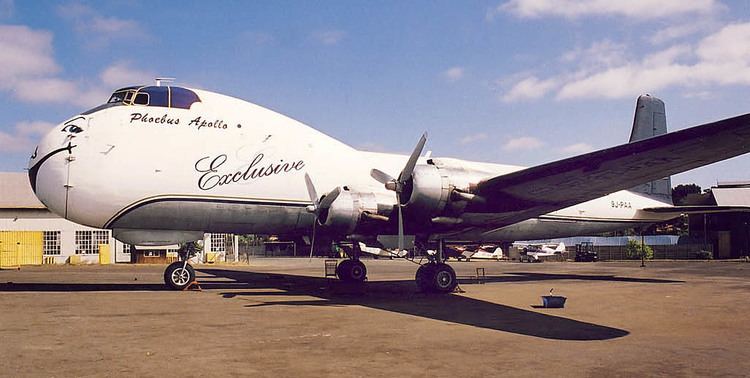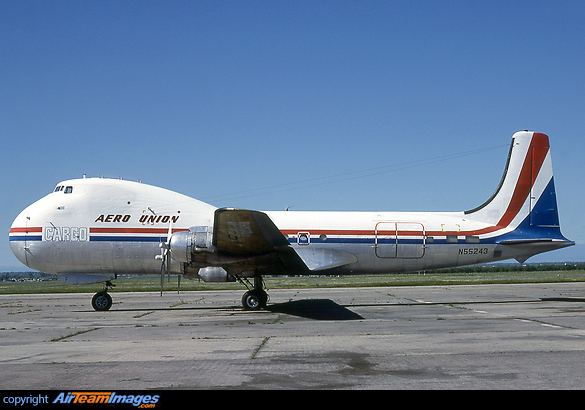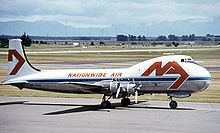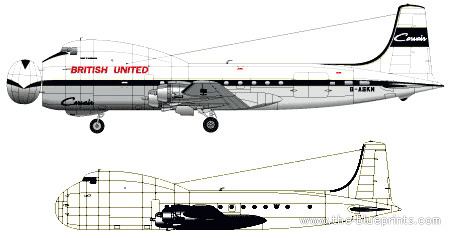Top speed 350 km/h Wingspan 36 m Cruise speed 334 km/h | Range 3,400 km Length 31 m First flight June 21, 1961 | |
 | ||
Engine type Pratt & Whitney R-2000 Twin Wasp | ||
Aviation traders carvair arriving at zestienhoven rotterdam airport netherlands wmv
The Aviation Traders ATL-98 Carvair was a large transport aircraft powered by four radial engines. It was a Douglas DC-4-based air ferry developed by Freddie Laker's Aviation Traders (Engineering) Limited (ATL), with a capacity of 25 passengers and five cars, loaded at the front.
Contents
- Aviation traders carvair arriving at zestienhoven rotterdam airport netherlands wmv
- Aviation traders carvair
- Design and development
- Service
- Survivors
- Past operators
- Specifications
- References

Aviation traders carvair
Design and development

Freddie Laker's idea to convert surplus examples of the Douglas DC-4 and its military counterpart the C-54 Skymaster to carry cars was a relatively inexpensive solution to develop a successor to the rapidly aging and increasingly inadequate Bristol 170 Freighter, the car ferry airlines' mainstay since the late 1940s.

The Bristol Freighter's main drawback was its limited payload, in terms of the number of cars that fitted into a single aircraft. Even the "long-nosed" Mark 32 was able to accommodate only three cars (in addition to 20 passengers). This made carrying cars by air a very tricky business. If a booked car failed to turn up, the flight instantly became unprofitable as a result of the one-third cut in payload. This situation was made worse by the increasing average length of British cars during the 1950s. The average UK car in 1959 was 25 centimetres (9.8 in) longer than in 1950. The extreme seasonality of the car ferry business furthermore resulted in poor aircraft utilization outside peak periods. Moreover, repeated takeoffs and landings on short cross-Channel flights, in turbulent air at lower altitudes with tight turnarounds of as little as 20 minutes, made the aircraft prone to structural fatigue problems. These necessitated rigorous and costly modification programmes, thereby further increasing the type's operating costs on what were essentially low-yield routes.

When the major airlines replaced their obsolete piston airliners with new Boeing 707 and Douglas DC-8 jets on their prestige long-haul routes, the unit price of second-hand DC-4s dropped to as little as £50,000. The conversion of each of these airframes into car-passenger carriers cost about £80,000. This was easily affordable by smaller airlines, such as the car ferry companies. Freddie Laker's cardboard model of a converted DC-4 featuring a door in the nose and a flight deck raised above the fuselage had shown that its payload was superior to the Bristol Freighter/Superfreighter. The aircraft was designed to accommodate five average-sized British cars plus 25 passengers as a result of the DC-4's longer and wider fuselage. (British Air Ferries (BAF), for example, operated its Carvairs in a flexible configuration, either accommodating five cars and 22 passengers or two-three cars and 55 passengers, permitting it to change over from one configuration to the other in about 40 minutes.) In addition, the DC-4's lack of pressurisation made it ideal for low-altitude cross-Channel flights that did not go high enough to require a pressurised cabin. This made the proposed structural conversion straightforward. The result was a new aircraft christened Carvair (derived from car-via-air).

Initially, it was thought that second-hand, pressurised Douglas DC-6 and Douglas DC-7 airframes could be converted into larger, "second generation" Carvairs within 15 years of the original DC-4-based Carvair's entry into service.

The actual conversion of the original aircraft entailed replacing the forward fuselage with one 8 feet 8 inches (2.64 m) longer, with a raised flightdeck in a bulbous "hump" (akin to the later Boeing 747) to allow a sideways hinged nose door. It also entailed more powerful wheel brakes and an enlarged tail, often thought to be a Douglas DC-7 unit, but actually a completely new design. The engines, four Pratt & Whitney R-2000 Twin Wasps, were unchanged.

The prototype conversion first flew on 21 June 1961. Twenty-one Carvairs were produced in the UK, with production of aircraft 1, 11 and 21 at Southend Airport and the balance at Stansted Airport. The final three aircraft were delivered to Australia's Ansett-ANA, which supplied its own DC-4s to ATL for conversion, unlike the previous 18 aircraft that were purchased by ATL and either sold on or transferred to associate company British United Air Ferries (BUAF). One of the two aircraft still flying in June 2007 was an ex-Ansett airframe. A second Ansett aircraft was abandoned at Phnom Penh in 1975. The first flight of the last conversion, number 21, for Ansett, was on 12 July 1968.

Basic price for a newly converted Carvair in 1960 was £150,000. This was the aircraft type used by Auric Goldfinger in the James Bond film Goldfinger to transport himself and his car to Geneva.
Service
The Carvair was used by Aer Lingus, BUAF and BAF among others, and was used in Congo-Kinshasa during 1960-1964, under contract to the United Nations. Aircraft for Aer Lingus were quickly convertible between 55 seats and 22 seats with five cars. Some aircraft were pure freighters with only nine seats. One aircraft had 55 high-density seats and room for three cars. BAF was the last operator in Europe of the aircraft, keeping them flying into the 1970s.
British United Carvairs made an appearance in the 1964 James Bond movie Goldfinger as Goldfinger and Oddjob boarded one for Switzerland while Goldfinger's Rolls-Royce car was being loaded through the Carvair nose, and in The Prisoner in the episode "The Chimes of Big Ben", where it is seen loading through the nose, taking off and then landing again.
Of the 21 airframes, eight were destroyed in crashes (one each in Rotterdam, Netherlands 1962; Karachi, Pakistan 1967; Twin Falls, Canada 1968; Le Touquet, France 1971; and four in the United States: Miami, Florida 1969; Venetie, Alaska 1997; Griffin, Georgia also in 1997; and McGrath, Alaska in 2007.) Perhaps the best-known Carvair crash was the one at Griffin in April 1997, where on its takeoff run the (fifth production) Carvair suffered catastrophic engine failure, failed to become properly airborne, and crashed into a vacant Piggly Wiggly supermarket past the airport perimeter, killing both pilots.
Survivors
The Zambian-registered 9J-PAA, the 21st and final Carvair built, is in South Africa with Phoebus Apollo Aviation. Although now removed from the Zambian register, the owner plans to return it to the skies for air shows. The second (N89FA / "Miss 1944", the 9th Carvair) is based in Gainesville, Texas at KGLE Gainesville Municipal Airport, and flies with Gator Global Flying Services on ad-hoc cargo charters throughout the United States. This was the aircraft that participated in the 2005 World Freefall Convention in Rantoul, Illinois, setting the record for the largest number of people to fly in a Carvair when it carried 80 skydivers and five crew to an altitude of 10,500 feet. Piloted by Captain John Harms and Captain Chris Rice, the climb took 38 minutes. The skydivers exited the large freight door at the rear of the aircraft. The aircraft is currently on display at Rand Airport, where it sits near other uncommon aircraft such as the Boeing 747SP.
Another Carvair (N898AT, the 20th built) had been airworthy, but was written off after crashing while landing on 30 May 2007 at the airstrip at Nixon Fork Mine in Alaska. Satellite imagery (Google Earth) dated September 2006 and still visible in 2014 shows the wreckage of the 7th Carvair on a sand and gravel bar at 67°1′16.63″N 146°31′53.51″W in the Chandalar River near Venetie, Alaska.
The cockpit section of the 8th Carvair, CF-EPV remains near the former Halesworth Airfield in Suffolk, England. The 18th Carvair, ex Aviaco / Dominicana HI-172, is rumored to still exist at the Hotel El Embajador in Santo Domingo in the Dominican Republic, as a bar/discothèque.
Past operators
Specifications
Data from Jane's All The World's Aircraft 1965-66
General characteristics
Performance
